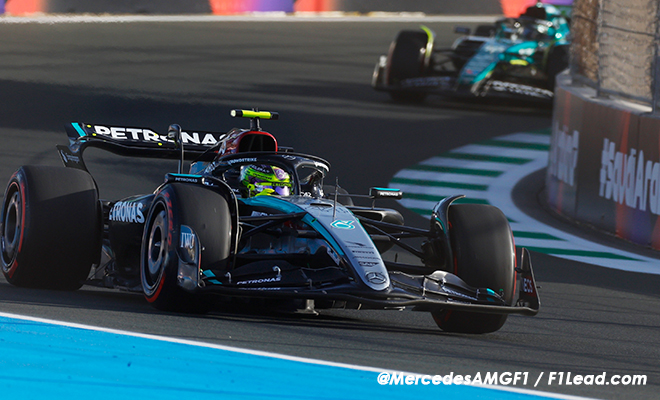At the Bahrain Grand Prix, Mercedes F1 faces an unanticipated cooling puzzle, challenging their technical team’s ingenuity and strategy.
Both teams had opted for extreme cooling setups—too extreme, in fact, as to avoid a withdrawal, Mercedes F1 had to dial down engine power and instruct their drivers to engage in lift-and-coast during the race.
In total, Toto Wolff estimated that both George Russell and Lewis Hamilton lost five-tenths per lap: a significant figure.
The issue is that James Allison, the team’s technical director, is not certain of the real source of this problem. Does this mean it could recur this weekend in Saudi Arabia?
“Actually, it’s the weekend’s biggest mystery that remains unsolved!”
“We were exposed to more heat during the race than we anticipated.”
“Choosing your cooling level for a weekend is always a bit of a gamble because you have to make that gamble after your free practice runs. And you have to bet on Sunday’s weather…”
“And normally, you also make some adjustments for different power levels and other things that can vary between the race and free practice.”
“This particular weekend was one where we had to make as few guesses as possible, since we had already used this cooling level numerous times in winter testing as well as in free practice.”
Yet, it was colder than usual during the race in Bahrain…
“The temperature we experienced on race day was incredibly close to what we had predicted. So, we had all the circumstances to make an accurate forecast of the power unit temperatures.”
“The fact that we were off by more than a degree or two is extremely unusual and quite penalizing, because once the cars exceed the limit at which the engine manufacturers guarantee the engine, we simply have to slow down the car.”
A power unit issue means not just fewer horses; it also means greater tire wear, continues James Allison.
“We have to lift off the throttle at the end of the straights, we have to dial down certain engine modes just so they survive. And that robs you of lap time, robs you of tire temperature, and ruins your race.”
The issue is still not resolved for Saudi Arabia
In just a few days, Mercedes F1 has not been able to pinpoint the origin of this problem: not exactly reassuring for James Allison!
“The problem is thus not yet resolved. It’s one of the things we have a work program for this week at the factory. We’re going to try to understand where it’s coming from, among the very small number of things that could have changed between free practice and the race. We’re going to try to find what led to an unexpected increase in temperature.”
“It will be a considerable relief when we’ve identified it and ensured it won’t recur this year.”
Therefore, one should not draw too negative a conclusion from George Russell’s race pace in Bahrain last Sunday. According to Andrew Shovlin, chief race engineer at Mercedes, Russell could have finished ahead of Charles Leclerc, at least, last Sunday.
“It was quite significant, we were losing about three-tenths per lap… But we were able to manage this issue effectively in other areas. And particularly in clean air, the loss was a bit less than that. But on the order of one to two tenths per lap over the race.”
“Where would we have finished without this? It’s certain that when George lost position to Charles [Leclerc], he then had to manage his pace a lot. This lift-and-coast he was doing to cool the power unit was also cooling the tires.”
“And he started to struggle a bit with understeer, to complain about the front of the car.”
Cooling Jeddah Mercedes F1. Cooling Jeddah Mercedes F1
- Verstappen tops first practice – Results
- Following us on Facebook and Twitter.
